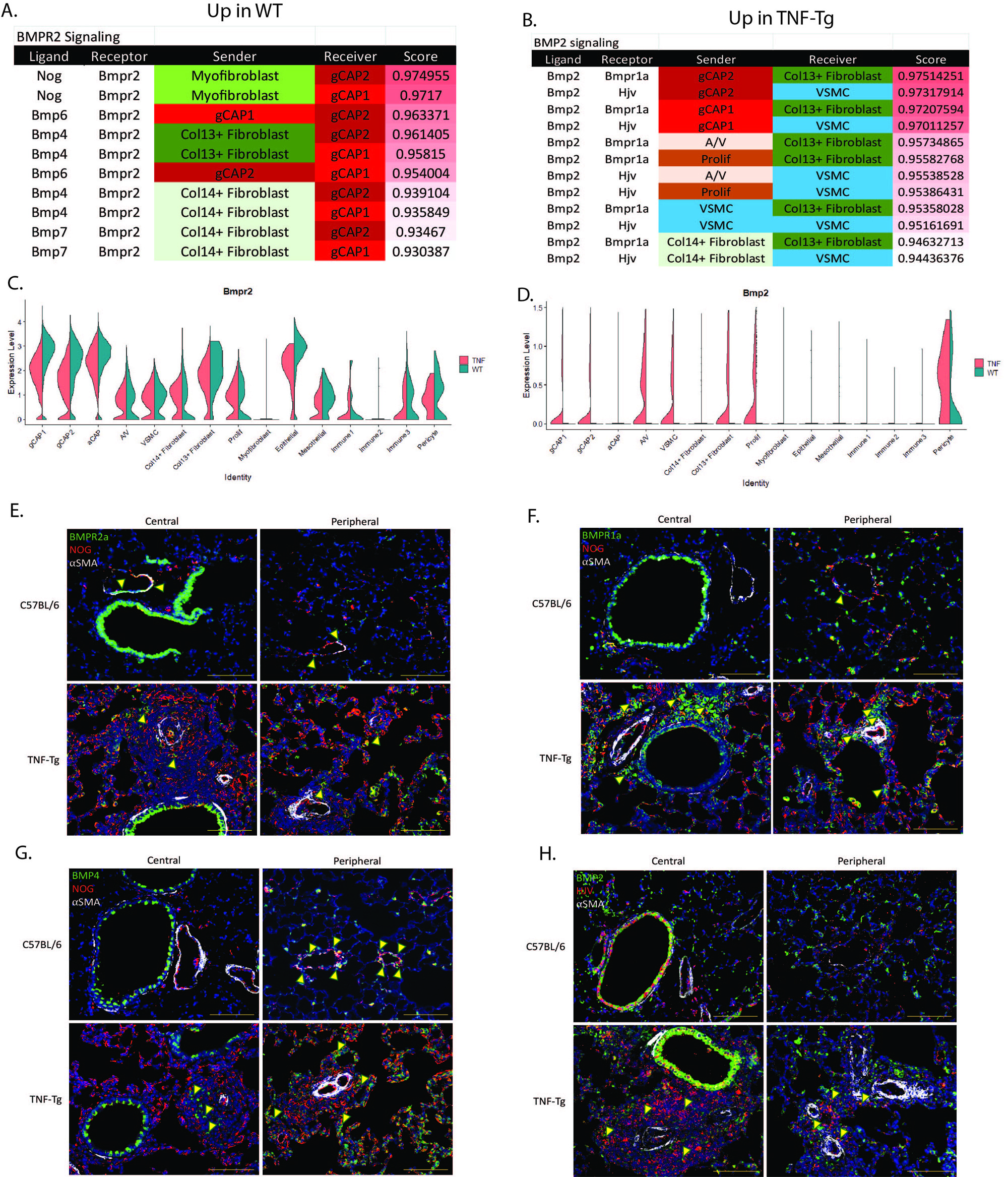Session Information
Date: Monday, November 13, 2023
Title: Abstracts: Systemic Sclerosis & Related Disorders – Basic Science
Session Type: Abstract Session
Session Time: 4:00PM-5:30PM
Background/Purpose: : We recently described TNF-transgenic mice as a novel model of pulmonary hypertension (PH) and have shown that they express altered endothelial and mesenchymal cell populations by single-cell RNA sequencing. Mutations in BMPR2 are known to cause genetic pulmonary arterial hypertension (PAH), and loss of BMPR2 function is seen in idiopathic forms of PAH, but the role of BMP signaling in inflammatory PH has not been well characterized.
Methods: Endothelial and mesenchymal cells were isolated from lungs from TNF transgenic mice and littermate controls at 8, 14, and 20 weeks of age (n=3-5 mice per timepoint and genotype).6000-8000 cells were used for droplet-based single cell capture (10X Genomics) and RNA sequencing. Data were analyzed using multinichenetr to assess for ligand-receptor (L:R) interactions between cell types in each condition. Putative L:R interactions were confirmed using immunostaining including stains for BMPR2, BMPR1a, BMP2, BMP4, Noggin, COL4A1, and ITGA2.Representative images were taken at both central/peribronchiolar areas and peripheral lung areas. aSMA was utilized to visualize vessels and as an anatomical landmark in other immunofluorescent stains BMPR2/Nog/aSMA, BMPR1a/Nog/aSMA, BMP4/Nog/aSMA, and Bmp2/Hjv/aSMA.
Results: Ligand-receptor analysis demonstrated an impaired interaction ofBMPR2 with BMP ligands (BMP4, BM6, and BMP7) in TNF-Tg PAH lungs, leading to the establishment of an alternative maladaptive BMP signaling cascade dominated by the interaction of BMP2 with BMPR1a and HJV (Figure 1 A-D).Immunofluorescence confirmed down-regulation of BMPR2 and BMP4 in TNF-Tg relative to WT littermates and up-regulation of BMPR1a, HJV, BMP2, and Noggin in TNF-Tg lungs (Figure 1E-H). L:R interactions between basement membrane proteins (COL4A1, HSPG2), TGF-beta family proteins, and integrins increased, while a decrease in pro-angiogenic signaling was observed in TNF-Tg mice (Figure 2). Circos plot and network analysis confirmed the centrality of altered BMP signaling in TNF-mediated PH pathogenesis (Figure 3).
Conclusion: Constitutive activation of TNF leads to loss of BMPR2 signaling and formation of an alternate weaker BMP signaling profile associated with increased TGF-beta/integrin and basement membrane protein expression in the PH cellular niche. Given the centrality of BMP signaling in PAH, this suggests that TNF is a key upstream mediator of pulmonary vascular disease and might represent an essential target for modulating PAH induced by inflammation and autoimmunity.
To cite this abstract in AMA style:
Rangel-Moreno J, Garcia-Hernandez M, Xu Q, Korman B. TNF-mediated Pulmonary Hypertension Is Marked by Aberrant Bone Morphogenic Protein (BMP) and Integrin/Basement Membrane Ligand-Receptor Signaling [abstract]. Arthritis Rheumatol. 2023; 75 (suppl 9). https://acrabstracts.org/abstract/tnf-mediated-pulmonary-hypertension-is-marked-by-aberrant-bone-morphogenic-protein-bmp-and-integrin-basement-membrane-ligand-receptor-signaling/. Accessed .« Back to ACR Convergence 2023
ACR Meeting Abstracts - https://acrabstracts.org/abstract/tnf-mediated-pulmonary-hypertension-is-marked-by-aberrant-bone-morphogenic-protein-bmp-and-integrin-basement-membrane-ligand-receptor-signaling/



